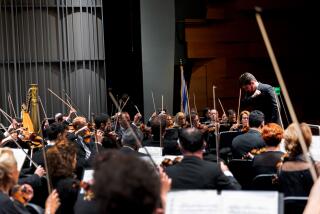Berkeley-Based Band Helps Keep Klezmer Music Kicking : Yiddish Tunes Meet the Jazz Age When the Klezmorim Play
- Share via
The exuberant Yiddish folk music known as klezmer is in the midst of a decade-long revival thanks, in large part, to a Berkeley-based band called the Klezmorim.
“They are the seminal group, the group that put klezmer music back on the map,” said Martin Schwartz, an associate professor of Near Eastern Studies at the University of California, Berkeley, and a klezmer music scholar who boasts more than 100 klezmer 78 r.p.m. recordings.
The Klezmorim, a six-man group that has been together in various incarnations since 1975, are bringing their hyperkinetic brand of Central European street music to the University Student Union at Cal State Northridge on Saturday, April 30, and to Pepperdine University on May 7.
Klezmer music, traditionally played in Eastern and Central Europe, was infused with a jazz syncopation in the 1920s when Jewish culture bloomed on Manhattan’s Lower East Side. The Klezmorim show is a pastiche that features skits, ballads that recount the origins of klezmer music and riffs that exemplify musical cross-pollination by jazz and classical artists.
Said tuba player Donald Thornton: “We want to educate as well as entertain our audience, to make sure that when people leave they know what klezmer music is, where it came from . . . even be able to pick up on some of the musical styles.”
Other members of the band are Charles Seavey on trombone, percussionist Andrew Marchetti, Christopher Leaf on trumpet, Benjamin Goldberg on clarinet and Sheldon Brown on saxophone.
According to Thornton, klezmer influences pop up in the music of Benny Goodman and Artie Shaw; in the works of such composers as Gershwin (the opening clarinet solo in “Rhapsody in Blue”) and Mahler (the lyrical central part of his First Symphony’s slow movement).
Klezmer music is what made Betty Boop bop in the old 1930s cartoons. It is what some movie directors used to evoke the heyday of sultans in old Constantinople or underscore chase scenes in exotic Levantine spice markets.
It also shows up in Jewish literature. Sholom Aleichem, a well-known Yiddish writer whose stories were adapted for “Fiddler on the Roof,” features a klezmer musician as the protagonist in the short story, “Stempenyu.”
Traditional klezmer music--the word comes from Hebrew and means “instrument of song”--uses Hasidic riffs, Greek and Turkish rhythmic dance music and slow, intense doinas, or instrumental laments once played by shepherds.
The Klezmorim have embraced this historic music, added the Dixieland notes of the Jazz Age that influenced later klezmer music, and mixed it with the vaudeville of San Francisco street musicians (one number features a trumpet-playing gorilla). A reviewer once said that the Klezmorim sound like “Czar Nicholas II’s house band as led by Spike Jones.”
Thornton prefers to say that the Klezmorim play in the style made popular by Lower East Side musicians in the 1920s, a time when klezmer music--and the Yiddish theater--flourished in New York’s Jewish community.
Several record companies had ethnic music divisions back then that catered to Central and Eastern European immigrants. Schwartz said it wasn’t uncommon for record companies to assemble klezmer musicians for an album and then recycle the songs for Serbo-Croatian or Balkan audiences merely by slapping on a new cover.
Thus, said Schwartz, a Romanian march turned out to be a slow, solemn klezmer song that commemorates the Day of Atonement. A Jewish dance orchestra was rebilled as festive Greek dances.
During the Depression, poverty and the forces of assimilation snuffed out much of the klezmer music, although it remained a staple at wedding celebrations.
It wasn’t until the mid-1970s that musicians began to display a new interest in klezmer music. In Berkeley, Lev Liberman was playing ethnic music and growing curious about the plaintive tunes he had heard throughout his childhood. His research took him to the musical archives of Berkeley’s Judah L. Magnes Memorial Museum, where he rooted around and found a cache of old klezmer records. He co-founded and played with the band for 12 years.
“The whole motivation was to discover this kind of music that was really exciting and interesting that no one else was playing,” said Thornton, who joined the Klezmorim in 1978. The Klezmorim have put out five albums, the latest called “Jazz Babies of the Ukraine.”
It takes stage experience to execute such organized slapstick. Two of the Klezmorim have played in orchestras; one is a street musician; two more have played in ethnic and rock ‘n’ roll bands. They work full time as musicians and spend about 100 days each year on tour.
Members of the Klezmorim said they frequently hear about new klezmer ensembles forming in urban areas. In the San Fernando Valley, for example, the Ellis Island Klezmer Band played earlier this month at the Valley Cities Jewish Community Theater in Van Nuys.
In addition, the Klezmorim said that to their surprise, bands also are forming in smaller cities like Cheyenne, Wyo., and Albuquerque, N.M.
Klezmer music has been performed on Garrison Keillor’s former “A Prairie Home Companion” radio show. Director Michal Goldman made a klezmer documentary that was shown on public television and is now making the rounds of art theaters.
“The upbeat aspect of klezmer has been stressed a lot in the revival but . . . it’s not all circusy,” said Schwartz, who added, somewhat wistfully, that he would like to see the most beautiful parts of klezmer music played more traditionally.
Although the Klezmorim include the traditional approach, they gear their show to a broad, general audience. The shtick, they maintain, must stay.
Said Thornton: “You can’t take the music too seriously. That’s no fun.”
More to Read
The biggest entertainment stories
Get our big stories about Hollywood, film, television, music, arts, culture and more right in your inbox as soon as they publish.
You may occasionally receive promotional content from the Los Angeles Times.










